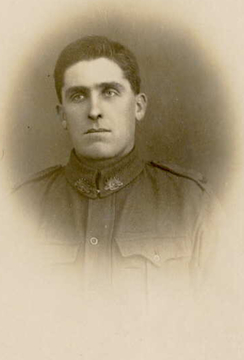
73995
PEEL, Edward
| Service Number: | 2914 |
|---|---|
| Enlisted: | Not yet discovered |
| Last Rank: | Private |
| Last Unit: | 1st Pioneer Battalion |
| Born: | Minmi, New South Wales, Australia, 5 March 1887 |
| Home Town: | Stanford Merthyr, Cessnock, New South Wales |
| Schooling: | Not yet discovered |
| Occupation: | Engineer / Electrical Fitter |
| Died: | Kurri Kurri, New South Wales, Australia, 23 June 1975, aged 88 years, cause of death not yet discovered |
| Cemetery: |
South Maitland (Kurri Kurri) Cemetery Congregational |
| Memorials: |
World War 1 Service
| 17 Oct 1916: | Involvement Private, 2914, 1st Pioneer Battalion, --- :embarkation_roll: roll_number: '4' embarkation_place: Sydney embarkation_ship: HMAT Borda embarkation_ship_number: A30 public_note: '' | |
|---|---|---|
| 17 Oct 1916: | Embarked Private, 2914, 1st Pioneer Battalion, HMAT Borda, Sydney | |
| 11 Nov 1918: | Involvement Private, 2914 |
Edward Peel
Private Edward Peel, Service No. 2914 was an Australian soldier, one of over 330,000, who served overseas with the Australian Imperial Force (AIF) during World War. He was the sixth of eight children born to Margaret (nee Gray) and Ralph Peel in 1887 in Minmi, NSW, a once-thriving coal-mining hamlet on the outskirts of Newcastle. He suffered the tragic loss of his parents at a young age. Undertaking studies years later at night school, perhaps with a desire to progress, he completed Electrical in Mining with Honours just before the outbreak of war, and it was during this time he met Agnes Williams whom he married in 1915.
Edward joined the AIF on 15 May 1916 at West Maitland, and his military career began on 6 June when he signed his oath at Victoria Barracks. His attestation papers show he was allotted to the reinforcements, 1st Pioneer Battalion (The Battalion) who were attached to the 1st Australian Division, and to equip him for his time at war, his training began at the Engineer’s Depot at Moore Park, which bought together all engineers and allied trades of the Commonwealth.
Embarking on HMAT Borda on 17 October 1916, Edward arrived in England three months later where he undertook training at the Parkhouse Depot, before his long-awaited departure for Etaples, France where he was taken on strength by the 6th reinforcements on 11 May 1917 and joined The Battalion at Bancourt on the Western Front. Unit diaries show over the next two months The Battalion moved to several camps in the Somme region where they underwent training, rest, divisional sport, and even an inspection by the king.
The Battalion arrived in Lumbre on 31 July, the same day the Third Battle of Ypres was launched, and they worked under instructions to construct rifle ranges, gun-pits, and dugouts. The Battalion was taken by motor buses on 7 September to the forward area of Ypres, in the Belgium countryside which now consisted wholly of abandoned fields, shell-holes, and a handful of half-broken buildings. One wonders what Edward thought of his time at the forward edge, as he clutched his pick and shovel, constructing roads, railway, and communication trenches, whilst battling the trying conditions encountered when under the murderous shell fire and gas attacks, which would become the bloodiest of campaigns for the AIF, resulting in 40,719 casualties. Casualty records show, just two days before the infantry’s first major operation at Menin Road on 20 September, Edward was wounded in action.
Edward suffered a gunshot wound to his right arm and was taken by field ambulance to the Casualty Clearing Station, then transported to England where he was admitted to the 2nd Military Hospital, Old Park, Canterbury for surgery. On transferring to the 3rd Auxiliary Hospital, Dartford for final treatment there was no rest on his first night of admission, as the air raid sirens sounded, and planes were heard overhead with shrapnel flying freely. On discharge three weeks later, he resided at the Command Depot No. 4, and once ‘hardened’ up he could return to active service. Deemed ready to return to the front he was transported to the Overseas Training Brigade to prepare him once again for life in the trenches.
Edward returned to France in December and re-joined his battered Division at Messines for the remainder of the bitter winter. The Germans launched their Spring Offensive, and The Battalion made their way to the Hazebrouck region in April, as they constructed the new-reserve trench system and defences and were successful in halting the German offensive. In June, he was detached for duty with the 1st Mechanical Transport Company who was responsible for collecting and distributing food, ammunition, and ordnance stores. His time in France came to an end 3 months later when he was invalided back to England after receiving accidental burns to his hands. On 25 March 1919, Edward was invalided to Australia aboard HMAT Port Denison and discharged on 25 September and for his campaign service, he received the British War, Victory, and Star Medals.
On returning home, Edward worked as a mine electrician and was promoted to the position of chief electrical engineer where he took responsibility for all electrical staff. He served the community as a Justice of the Peace, and again he prepared to serve his country in the Second World War, though was rejected due to an untreatable hernia he received in the trenches. Edward and Agnes were blessed with a long and happy marriage.
Sourced and submitted by Ann Meldrum (great niece) 1 October 2021.
Submitted 1 October 2021 by Ann Meldrum









